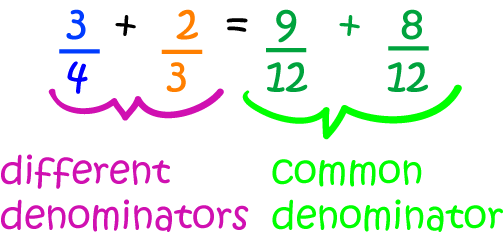Math Definitions - Letter C
Chapters
Common Denominator
Definition of Common Denominator

A common denominator occurs when two or more fractions have the same denominator.
In order to add or subtract fractions, we need them to have a common denominator. All is not lost, however. We can put fractions over a common denominator.
To do this, we multiply both the top and bottom of each fraction by an equal amount.
For example, to add \(\dfrac{1}{5}\) and \(\dfrac{2}{3}\):
- Multiply \(\dfrac{1}{5}\) by \(\dfrac{3}{3}\) and multiply \(\dfrac{2}{3}\) by \(\dfrac{5}{5}\).
- Then \(\dfrac{1}{5}\) becomes the equivalent fraction \(\dfrac{3}{15}\), and \(dfrac{2}{3}\) becomes the equivalent fraction \(\dfrac{10}{15}\).
- These two fractions have the common denominator of \(15\), so we can add them!
- Calculate: \(\dfrac{3}{15} + \dfrac{10}{15} = \dfrac{13}{15}\ ).
Description
The aim of this dictionary is to provide definitions to common mathematical terms. Students learn a new math skill every week at school, sometimes just before they start a new skill, if they want to look at what a specific term means, this is where this dictionary will become handy and a go-to guide for a student.
Audience
Year 1 to Year 12 students
Learning Objectives
Learn common math terms starting with letter C
Author: Subject Coach
Added on: 6th Feb 2018
You must be logged in as Student to ask a Question.
None just yet!